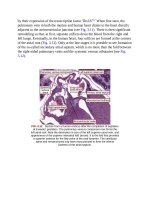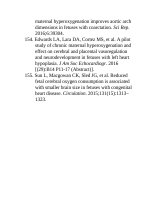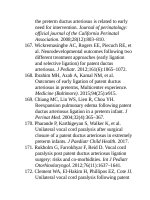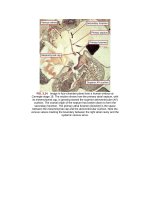Andersons pediatric cardiology 1182
Bạn đang xem bản rút gọn của tài liệu. Xem và tải ngay bản đầy đủ của tài liệu tại đây (81.02 KB, 3 trang )
AorticStenosis
Leftventricularsystolicdysfunction
Symptomsofheartfailure,syncope,exertionaldyspnea,orangina
AsymptomaticwithmeanDoppler-derivedgradient>60mmHgby
echocardiography
Asymptomaticwithprogressivelyreducedexercisecapacityon
cardiopulmonaryexercisetesting
Asymptomaticwithhigh-riskexercisestresstestdemonstratingsymptoms
ofangina,ischemicelectrocardiographicchanges,orhypotensionduring
exertion.
Inadultswithsevereaorticstenosis,theguidelinespublishedbytheAmerican
CollegeofCardiologyandAmericanHeartAssociationrecommendaorticvalve
interventionifthereisassociated(1)leftventricularsystolicdysfunction,
definedasejectionfractionlessthan50%,and/or(2)symptomsofheartfailure,
syncope,exertionaldyspnea,angina,orpresyncopebyhistoryoronexercise
testing.58
However,pediatricpatientsaregenerallylowersurgicalriskthanadult
patients.Inaddition,withalongerlifeexpectancy,theremaybeadvantagein
earlierinterventiontopreserveleftventricularsystolicfunctionbefore
maladaptivemyocardialremodelingbecomesirreversible.Thesefactorsmay
justifyearlierinterventioninchildrenwithsevereaorticvalvestenosiseven
priortotheonsetofsymptomsorventriculardysfunction.Ameanpressure
gradientof60mmHgorgreateracrosstheaorticvalvebyechocardiographyhas
beenrecommendedasanindicationforinterventioninasymptomaticyoung
patients.58
Exercisetestingcanbeusefultodetermineneedforearlyinterventionin
asymptomaticchildrenwithsevereaorticstenosisandpreservedleftventricular
systolicfunctionby(1)demonstratingobjectivereductionsinmeasuresof
exercisecapacity,(2)elicitingexertionalsymptomsinmoresedentary
individuals,(3)measuringafallinbloodpressurewithexercise,or(4)inducing
ischemicorrepolarizationchangesonelectrocardiogramduringexercise,allof
whicharehigh-riskclinicalfeaturesthatindicateneedforaorticvalve
intervention.
CatheterIntervention
Thetechniquefortranscatheterballoonaorticvalvuloplastyissimilartothatfor
neonates.Balloonvaluvuloplastymaybeconsideredinyoungadultswith
congenitalaorticstenosis;however,itistypicallynotsuccessfulinolderadults
duetosignificantcalcificationofthecuspsandsuboptimalresults.
Comparedwithsurgicalvalvotomy,theadvantagesofballoonaortic
valvuloplastyincludeavoidanceofcardiopulmonarybypassandsternotomy,
shorterhospitalstay,andlowercosts.Long-termsurvivalissimilarinboth
groupswitha10-yearsurvivalof90%inthesurgicalgroupversus87%inthe
balloongroup.105Thereisagreaterriskforaorticvalveregurgitationafter
ballooninterventionrelativetosurgery.Freedomfrommoderatetosevereaortic
regurgitationisapproximately60%at10years.82Inacomparativemetaanalysis,the10-yearfreedomfromreinterventionwaslowerfollowingballoon
interventionat46%comparedwith73%followingsurgicalintervention.105
However,thefreedomfromaorticvalvereplacementwassimilarbetweenboth
groups.Anothersingle-centerstudyalsoreportedlowerfreedomfrom
reinterventionof27%afterballoonvalvuloplasty,versus65%aftersurgical
valvotomyat5yearsoffollow-up,aswellasahigherneedforaorticvalve
replacementintheballoongroup.90
SurgicalIntervention
Opensurgicalvalvotomyfornoncriticalstenosiscanbeperformedwithverylow
mortality(2%to3%).However,thereremainsarelativelyhighrateof
reoperationofapproximately30%to40%at15to20years.106Bicuspidalization
oftheunicuspidvalveinyoungadultsworkswell.107Conversionofcongenitally
bicuspidaorticvalvestotricuspidarrangementmightconferbetteroutcomes,
probablyduetoreductionincuspsstressloadandimprovedflowpatterns,by
providingoptimaleffectiveorificearea.Reconstructionissafe,withearly
mortalityapproachingzeroandwitha5-yearfreedomfromvalvereplacement
upto75%.108–112Ingeneral,earlyvalvefunctionafterreconstructionis
excellent;however,long-termdurabilityofrepairisunknown.
Aorticvalvereplacementisperformedwhenrepairisnotfeasible.Optionsfor
valvereplacementincludemechanicalprostheticvalve,pulmonaryautograft
(Rossprocedure),orbioprostheticvalve.Theadvantagesanddisadvantagesof
thevariousoptionsofvalvereplacementarediscussedlaterinthesectionon
surgicalmanagementforaorticregurgitation.
Long-TermOutcomes
Patientswithcongenitalvalvaraorticstenosisrequirelife-longfollow-upfor
progressiveaorticvalvedysfunction,bothbeforeandafterintervention.Aortic
valveintervention,whetheritconsistsofballoonvalvuloplastyorsurgical
repair/replacement,shouldbeconsideredpalliative,andsubsequentmonitoring
isrequiredtoevaluateforneedforreinterventionovertime.Forpatientswith
bicuspidaorticvalve,surveillanceoftheascendingaortaisalsorequireddueto
theriskforprogressiveaorticdilationanddissection.









